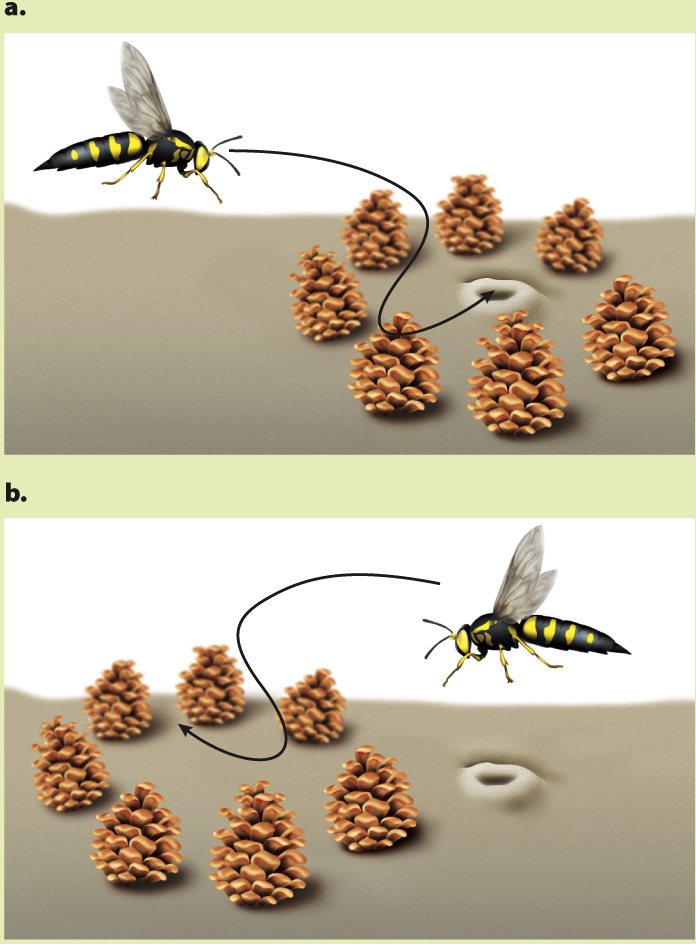Learning is an adaptation.
The capacity to learn often has adaptive functions. Much learning, including human learning, is based on imitation: One individual copies another. Learning by imitation was famously observed in the days when people in Britain had milk deliveries left outside on the doorstep. As we saw in Chapter 24, a number of birds, including Great Tits and Blue Tits, learned to open foil-
The capacity to learn a particular task seems in many instances to be innate. Female digger wasps are foragers. Tinbergen showed that a digger wasp learns the landmarks around her nest and then uses this information to find her way back to it from hunting. In his experiment, illustrated in Fig. 45.10, Tinbergen placed a ring of pine cones around a wasp’s nest and, after she had flown out and returned a few times, moved the circle of pine cones to the side of the nest. The returning wasp now flew past her own nest and went directly to the center of the ring. This innate ability to learn landmarks is adaptive: It improves the survival or reproductive success of the individual.
991
HOW DO WE KNOW?
FIG. 45.10
To what extent are insects capable of learning?
BACKGROUND European digger wasps, Philanthus triangulum, live in the sand. These wasps are sometimes called “bee wolves” because they specialize on hunting for honeybees to feed their developing young. After mating, each female digs a long burrow with a few chambers at the end where she lays her eggs. She then forages for honeybees that she brings back to these chambers for her larvae to eat. The wasp faces a navigational challenge: Having captured her prey, how can she find her way back to and recognize her nest? Niko Tinbergen noticed that wasps lingered briefly near a new nest before heading off to hunt, and thought that they were learning local landmarks associated with the nest.
HYPOTHESIS The wasp learns visual cues around her nest to help her locate it upon her return.
METHOD Tinbergen recognized that a good test of the learning abilities of an insect should take place in its natural environment. He combined his skills as a naturalist and as an experimentalist to devise an elegant demonstration of the way in which female wasps learn landmarks for navigation. Tinbergen’s approach was simple. He placed a ring of pine cones around the nest of a wasp, and then, once she had left to hunt, he shifted them to a new location away from the nest entrance. If visual cues are key, the wasp would return to the displaced pine cone ring. On the other hand, if cues are, for example, olfactory, she would return directly to the nest.
RESULTS Females carried out a brief landmark-

CONCLUSION Female digger wasps learn and then use local landmarks, such as the experimental ring of pine cones, as cues to the nest location.
SOURCE Tinbergen, N. 1958. Curious Naturalists. New York: Basic Books.
This adaptive aspect of animal learning is also revealed by taste aversion experiments, in which an animal typically learns to avoid certain flavors associated with a negative outcome. Rats learn to avoid flavored water if consuming it is associated with nausea. However, they do not learn to avoid flavored water if it is associated with a different kind of negative reinforcement, such as a mild electric shock. Rats, then, can make some associations, but not others. The ones they can learn are the biologically meaningful ones, those that favor survival. In the course of evolution, the rat’s ancestors encountered poisoned food that resulted in nausea and the aversion response evolved. Until humans started doing experiments on them, rats had never encountered a meal that resulted in an electric shock. It is not surprising, then, that the ability to pair these two phenomena never evolved. These experiments also show that the specific evolutionary history of the species in question matters when analyzing animal behavior.
992
In addition to adaptive predispositions for what can be learned and not learned, many species exhibit predispositions for when learning takes place. This is particularly evident in imprinting, a form of learning typically seen in young animals in which they acquire a certain behavior in response to key experiences during a critical period of development. Konrad Lorenz made imprinting famous by exploiting the observation that newly hatched goslings and ducklings rapidly learn to treat any sufficiently large moving object they happen to see shortly after hatching as their mother. Lorenz found that, if he was the first person the hatchlings saw, they would follow him as though he were their mother (Fig. 45.11).

This behavior is adaptive because the first being that a hatchling normally sees is a parent and the resulting close parent–
Experiments have shown that filial imprinting typically occurs during a specific, sensitive period in the animal’s life and that the results are usually irreversible. After Lorenz’s baby ducks had imprinted on him, they would not change their minds about who their parent was even when presented with their real mother duck. The timing of the sensitive period varies from species to species. In some cliff-